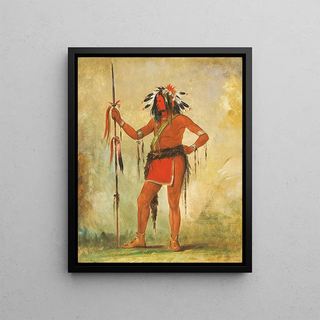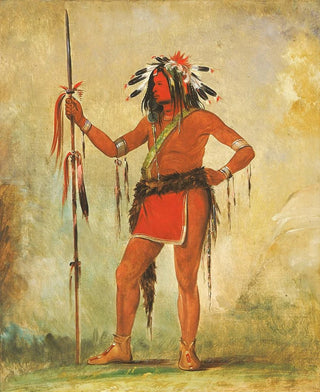Art print | Ch-Be-Mb-Bee The one who sits everywhere is a brave - George Catlin


View from behind

Frame (optional)
In the vibrant universe of American art, George Catlin's work stands out for its ability to capture the very essence of Native American cultures. The art print Ch-Be-Mb-Bee Celui qui est assis partout est un brave - George Catlin, emblematic of his artistic journey, immerses us in an era when the identity and spirituality of indigenous peoples were still preserved. Through this painting, the artist invites us to contemplate not only a portrait but also a visual story rich in emotions and meanings. Every brushstroke seems to resonate with a story, that of a man, a culture, and a changing world.
Style and uniqueness of the work
George Catlin's style is deeply rooted in the tradition of portraiture, but he transcends this genre with his unique approach and sensitivity. In Ch-Be-Mb-Bee, he does not merely depict his subject realistically; he captures the soul of the individual. The vivid colors and meticulous details of traditional attire reveal a careful attention to cultural authenticity. Catlin uses earthy tones that evoke the deep connection between man and his environment, while the majestic posture of Ch-Be-Mb-Bee, sitting with dignity, suggests quiet authority. This painting is a testament to the richness of Native American traditions, while also offering a reflection on the place of the individual within the vast panorama of history.
The artist and his influence
George Catlin, born in 1796, is often considered one of the first artists to dedicate his career to the representation of indigenous peoples of North America. His passionate commitment to preserving their culture and way of life is evident in each of his works. Catlin traveled across the continent, meeting tribes, establishing authentic connections, and documenting their rituals, costumes, and faces. His work not only contributed to a better understanding of Native American cultures but also influenced many artists and writers who followed his example. By highlighting the beauty and dignity of indigenous peoples

Matte finish

View from behind

Frame (optional)
In the vibrant universe of American art, George Catlin's work stands out for its ability to capture the very essence of Native American cultures. The art print Ch-Be-Mb-Bee Celui qui est assis partout est un brave - George Catlin, emblematic of his artistic journey, immerses us in an era when the identity and spirituality of indigenous peoples were still preserved. Through this painting, the artist invites us to contemplate not only a portrait but also a visual story rich in emotions and meanings. Every brushstroke seems to resonate with a story, that of a man, a culture, and a changing world.
Style and uniqueness of the work
George Catlin's style is deeply rooted in the tradition of portraiture, but he transcends this genre with his unique approach and sensitivity. In Ch-Be-Mb-Bee, he does not merely depict his subject realistically; he captures the soul of the individual. The vivid colors and meticulous details of traditional attire reveal a careful attention to cultural authenticity. Catlin uses earthy tones that evoke the deep connection between man and his environment, while the majestic posture of Ch-Be-Mb-Bee, sitting with dignity, suggests quiet authority. This painting is a testament to the richness of Native American traditions, while also offering a reflection on the place of the individual within the vast panorama of history.
The artist and his influence
George Catlin, born in 1796, is often considered one of the first artists to dedicate his career to the representation of indigenous peoples of North America. His passionate commitment to preserving their culture and way of life is evident in each of his works. Catlin traveled across the continent, meeting tribes, establishing authentic connections, and documenting their rituals, costumes, and faces. His work not only contributed to a better understanding of Native American cultures but also influenced many artists and writers who followed his example. By highlighting the beauty and dignity of indigenous peoples






